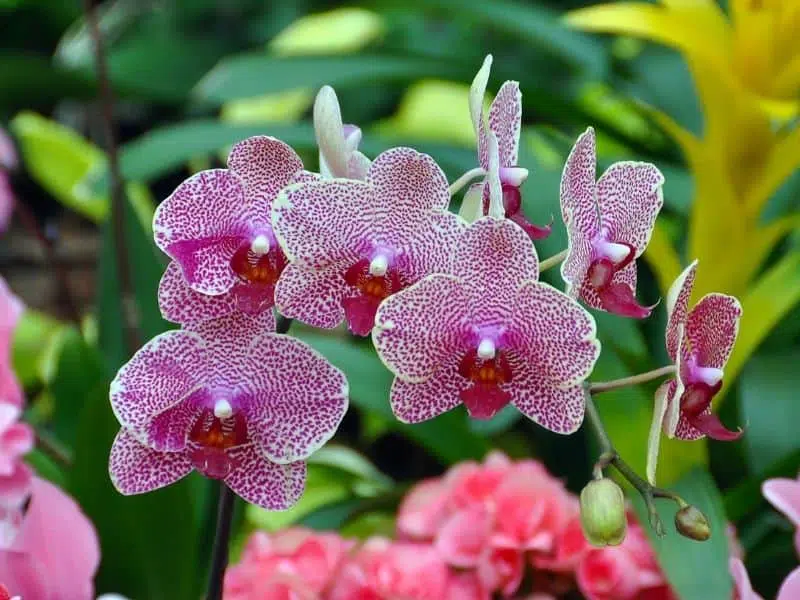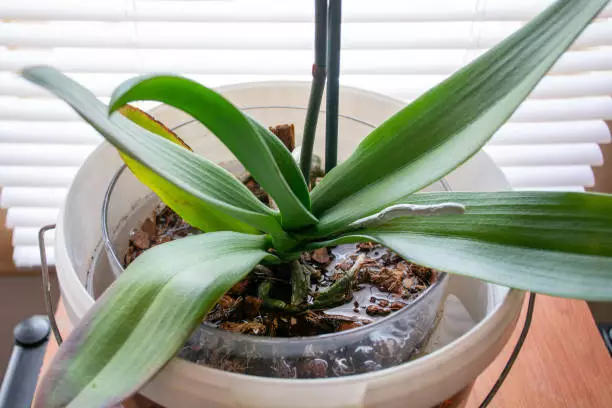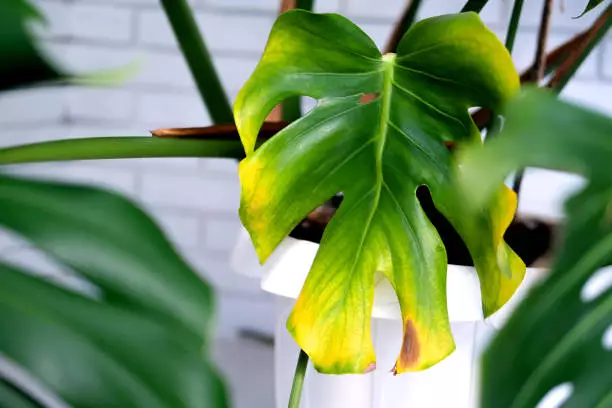Calathea is a genus of plants that belongs to the family Marantaceae. These plants are native to the tropical regions of the Americas, and they are commonly grown as houseplants due to their low maintenance requirements.
One of the fascinating aspects of Calathea plants is the wide variety of leaf patterns and colors that they exhibit. Different varieties of Calathea have distinct leaf shapes, sizes, and colors. Some of the most popular Calathea varieties include Calathea ornata, Calathea lancifolia, and Calathea zebrina. Each of these varieties has its unique characteristics and care requirements, making them a favorite among plant enthusiasts.
In this article, we will explore some of the most popular types of Calathea plants and their unique features. Whether you are a seasoned plant collector or a beginner, this article will provide you with the information you need to choose the perfect Calathea variety for your home or garden.
Calathea Varieties
Calathea is a genus of plants that includes a wide variety of species and cultivars. Here are some of the most popular Calathea varieties and their unique characteristics.
Rattlesnake Plant
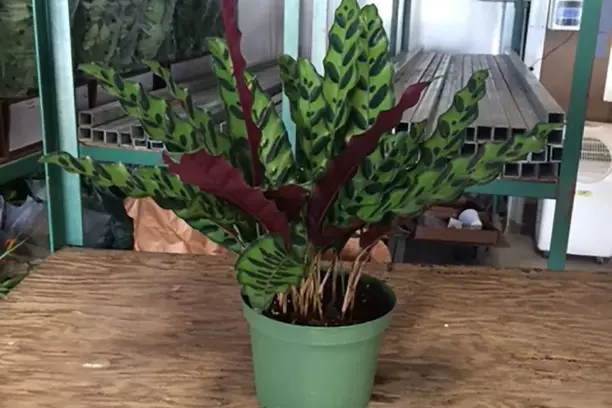
The Rattlesnake Plant, also known as Calathea lancifolia, is a popular Calathea variety with long, narrow leaves that have a green and purple pattern. It is a low-maintenance plant that is perfect for beginners.
Calathea Orbifolia
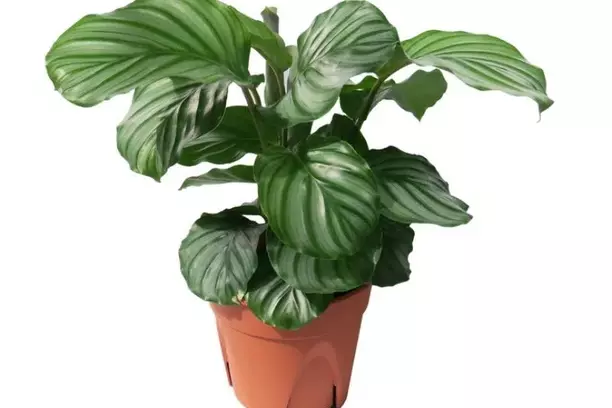
Calathea Orbifolia is a stunning Calathea variety with large, round leaves that have a silver and green pattern. It is a bit more difficult to care for than some other Calathea varieties, but it is definitely worth the effort.
Rose Painted Calathea
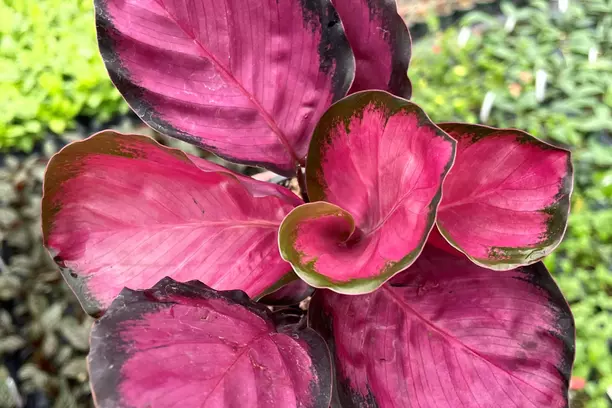
Also known as Calathea Roseopicta, the Rose Painted Calathea, is a beautiful Calathea variety with dark green leaves and pink stripes. It is a bit more sensitive to light and humidity than some other Calathea varieties, so it requires a bit more attention.
Peacock Plant
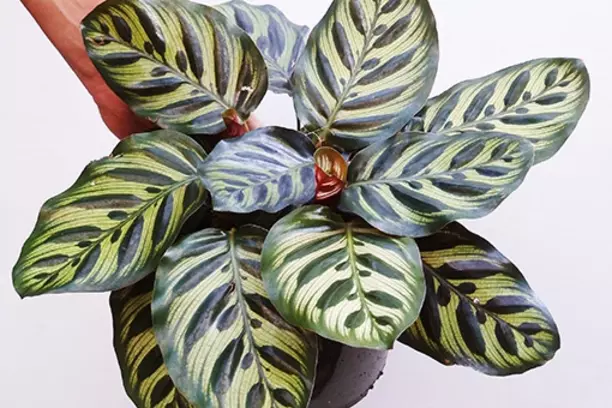
Peacock plant (Calathea Makoyana), is a stunning Calathea variety with dark green leaves and a pattern of light green stripes. It is a low-maintenance plant that is perfect for beginners.
Calathea Rufibarba
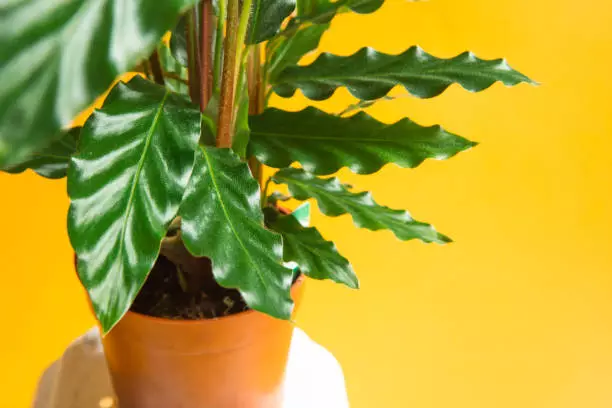
Calathea Rufibarba, also known as the Velvet Calathea, is a unique Calathea variety with dark green leaves and a velvety texture. It is a bit more sensitive to light and humidity than some other Calathea varieties, so it requires a bit more attention.
Eternal Flame
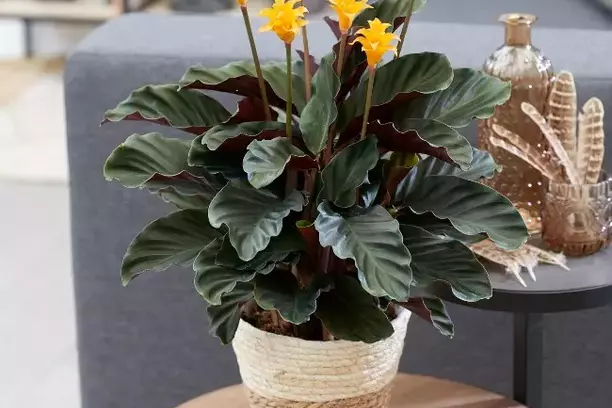
Eternal Flame is a stunning Calathea variety with dark green leaves and bright orange-red flowers. It is a bit more difficult to care for than some other Calathea varieties, but it is definitely worth the effort.
With the scientific name of Calathea Crocata, the Eternal Flame Plant, is a beautiful Calathea variety with dark green leaves and bright orange-red flowers. It is a bit more sensitive to light and humidity than some other Calathea varieties, so it requires a bit more attention.
Calathea Zebrina
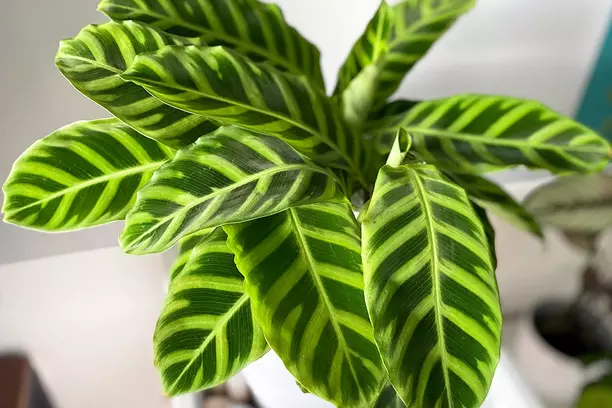
Calathea Zebrina, also known as the Zebra Plant, is a unique Calathea variety with dark green leaves and a pattern of light green stripes. It is a low-maintenance plant that is perfect for beginners.
Calathea Musaica
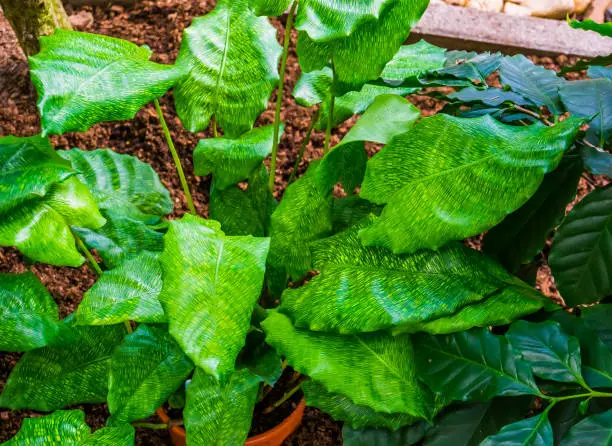
Calathea Musaica is a stunning Calathea variety with dark green leaves and a pattern of light green stripes that resemble a mosaic. It is a bit more difficult to care for than some other Calathea varieties, but it is definitely worth the effort.
Calathea Ornata
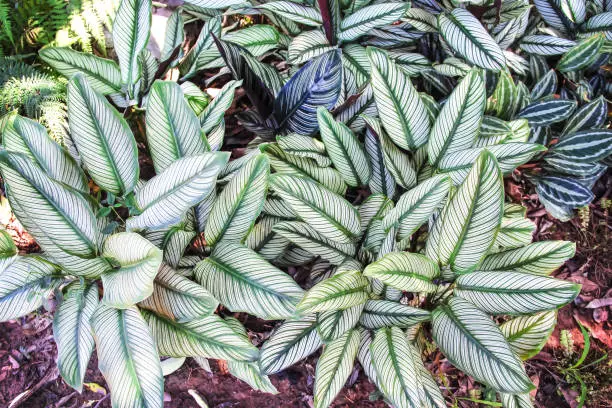
Calathea Ornata, also known as the Pinstripe Plant, is a beautiful Calathea variety with dark green leaves and pink stripes. It is a bit more sensitive to light and humidity than some other Calathea varieties, so it requires a bit more attention.
Calathea Warscewiczii
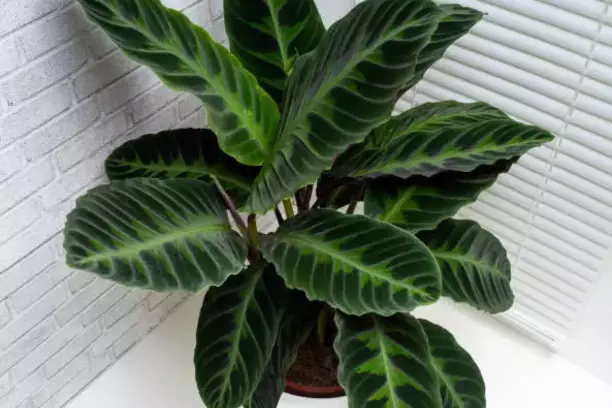
Calathea Warscewiczii, also known as the Jungle Velvet Calathea, is a unique Calathea variety with dark green leaves and a velvety texture. It is a bit more sensitive to light and humidity than some other Calathea varieties, so it requires a bit more attention.
Calathea Louisae
Calathea Louisae is a stunning Calathea variety with dark green leaves and a pattern of light green stripes. It is a bit more difficult to care for than some other Calathea varieties, but it is definitely worth the effort.
Calathea Lutea
Calathea Lutea is a beautiful Calathea variety with dark green leaves and yellow flowers. It is a bit more sensitive to light and humidity than some other Calathea varieties, so it requires a bit more attention.
Calathea Albertii
Calathea Albertii is a unique Calathea variety with dark green leaves and a pattern of light green stripes. It is a low-maintenance plant that is perfect for beginners.
In conclusion, Calathea is a diverse genus of plants with many unique varieties and characteristics. Whether you are a beginner or an experienced plant parent, there is a Calathea variety that is perfect for you.
Caring for Calatheas
Calatheas are tropical plants that require specific care to thrive. Here are some tips on how to care for your Calatheas:
Watering
Calatheas require consistently moist soil, but they do not like to sit in standing water. Water your Calatheas thoroughly when the top inch of soil feels dry to the touch. Ensure that the pot has drainage holes and that excess water is drained away.
Sunlight
Calatheas prefer bright, indirect sunlight. Direct sunlight can scorch their leaves, so it is best to place them near a window that receives filtered light or in a shaded area.
Temperature
Calatheas prefer warm temperatures between 65-80°F (18-27°C). Avoid placing them in areas with cold drafts or temperatures below 60°F (15°C).
Humidity
Calatheas require high humidity to thrive. You can increase humidity levels by placing a tray of water near the plant, using a humidifier, or grouping them with other plants to create a humid microclimate.
Fertilizer
Fertilize your Calatheas every 2-3 months during the growing season (spring and summer) with a balanced, water-soluble fertilizer. Avoid fertilizing during the dormant season (fall and winter).
By following these care tips, you can ensure that your Calatheas remain healthy and vibrant.
Calathea Growth and Behavior
Movement
Calathea plants are known for their unique ability to move their leaves, which is called nyctinasty. This movement is a response to changes in light and temperature, and it allows the plant to maximize its exposure to sunlight and minimize water loss. The movement is not rapid or sudden, but rather a slow and gradual process that occurs over the course of a day.
Blooming
Calathea plants are known for their beautiful, colorful blooms. The flowers are typically small and inconspicuous, but they are surrounded by brightly colored bracts that make them stand out. The blooms are typically produced in the spring and summer, but some species may bloom year-round under the right conditions.
Height and Growth
Calathea plants vary in size, ranging from small, compact plants to large, bushy specimens. The rate of growth also varies depending on the species and growing conditions. Some species may grow quickly and reach their full size in just a few years, while others may take several years to reach maturity.
Calathea plants also have a tendency to fold their leaves at night, which is called nyctinasty. This behavior is thought to help protect the plant from cold temperatures and dew, as well as to conserve water.
Overall, Calathea plants are fascinating and unique plants that are prized for their beautiful foliage and interesting growth and behavior. With proper care and attention, these plants can thrive and provide years of enjoyment for their owners.
The Beauty of Calatheas
Calatheas are known for their unique and striking patterns, making them a popular choice for indoor plants. These plants are native to South America and are a part of the Marantaceae family. Calatheas are known for their beautiful foliage, which comes in a variety of colors and patterns.
Color Variations
Calatheas come in a range of colors, from green to purple to pink. One of the most popular calatheas is the peacock plant, which has a striking pattern of green and purple. Another popular variety is the zebra plant, which has bold stripes of white and green. The underside of some calatheas’ leaves can also be a beautiful shade of purple, adding an extra pop of color.
Unique Patterns
The patterns on calatheas are what make them truly unique. Some have bold stripes, while others have a more subtle pinstripe pattern. The foliage on some varieties can even resemble a peacock’s feathers. The patterns on calatheas are not only beautiful but also serve a purpose. The patterns help the plant absorb more light, which is essential for their growth.
Floral Display
Calatheas also produce beautiful flowers. Some varieties have white flowers, while others have orange flowers. The flowers are not as showy as the foliage, but they add an extra element of beauty to these already stunning plants.
In conclusion, calatheas are a beautiful addition to any indoor plant collection. With their wide range of colors and unique patterns, they are sure to add a striking touch to any room.
Calathea as Houseplants
Calathea plants are a popular choice for indoor gardening enthusiasts due to their striking foliage and easy care requirements. They are native to tropical regions of South and Central America, and their natural habitat provides some clues as to how to care for them indoors.
One of the most appealing features of calathea plants is their ability to thrive in low light conditions. This makes them an ideal choice for indoor spaces with limited natural light, such as offices or apartments. However, they also appreciate bright, indirect light, so placing them near a north-facing window can be beneficial.
Calathea plants also require consistent moisture levels to thrive. They prefer well-draining soil that is kept consistently moist but not waterlogged. It’s important to avoid letting the soil dry out completely between waterings, as this can lead to leaf damage and other issues.
Another benefit of calathea plants is their air-purifying properties. They have been shown to remove toxins such as formaldehyde and benzene from the air, making them a great choice for improving indoor air quality.
Overall, calathea plants are a great choice for anyone looking for an easy-to-care-for indoor plant with striking foliage and air-purifying properties. With a little attention to lighting and watering needs, they can thrive in a variety of indoor spaces.
Calathea and Its Family
Calathea is a genus of plants belonging to the Marantaceae family, which is a family of flowering plants native to tropical areas of Africa and the Americas. The Marantaceae family is known for its ornamental and medicinal plants, such as arrowroot and prayer plants.
Calathea, formerly known as Goeppertia, is the largest genus in the Marantaceae family with over 300 species. The genus is known for its beautiful foliage, which has intricate patterns and vibrant colors. Calathea plants are mainly grown as indoor plants and in tropical garden landscaping due to their aesthetic appeal.
The Marantaceae family is characterized by its unique floral features, such as the presence of bracts and the arrangement of the flowers on the inflorescence. The family also has a distinctive leaf morphology, with leaves that are often broad, ovate, and have parallel veins.
Calathea is closely related to other genera in the Marantaceae family, such as Maranta and Stromanthe. These genera share similar morphological features, such as the presence of bracts and the arrangement of flowers on the inflorescence. However, Calathea is distinguished from other genera in the family by its unique leaf morphology and pattern.
In conclusion, Calathea is a genus of plants in the Marantaceae family known for its beautiful foliage and ornamental value. The family is characterized by its unique floral and leaf morphology, and Calathea is closely related to other genera in the family such as Maranta and Stromanthe.
Frequently Asked Questions
What are some Calathea varieties with pictures and names?
There are several Calathea varieties, and each has its unique features and characteristics. Some of the popular Calathea varieties include Calathea Medallion, Calathea Orbifolia, Calathea Freddie, Calathea Makoyana, and Calathea Zebrina, among others. You can find pictures and names of some of these varieties on this website.
What are the different types of Calathea with pictures?
Calathea plants belong to the Marantaceae family, and there are over 300 different species. Some of the most common types of Calathea include Calathea Medallion, Calathea Orbifolia, Calathea Freddie, Calathea Makoyana, Calathea Zebrina, Calathea Lancifolia, and Calathea Roseopicta. You can find pictures of these types of Calathea on this website.
How can I identify my Calathea plant?
To identify your Calathea plant, you need to look at its leaves, stem, and flowers. Calathea plants have large, oval-shaped leaves with intricate patterns and colors. The stem of the plant is usually green, and the flowers are small and inconspicuous. You can also identify your Calathea plant by its size, as some varieties can grow up to 3 feet tall.
What are some of the most beautiful Calathea plants?
Calathea plants are known for their beautiful foliage, and some of the most stunning varieties include Calathea Medallion, Calathea Orbifolia, Calathea Freddie, Calathea Makoyana, and Calathea Roseopicta. These plants have intricate patterns and colors on their leaves, making them a popular choice for indoor decoration.
What are the most difficult Calathea plants to care for?
Some Calathea plants can be more challenging to care for than others. Calathea plants that require high humidity and consistent moisture, such as Calathea Orbifolia, Calathea Freddie, and Calathea Makoyana, can be more difficult to care for. These plants require specific conditions to thrive, such as regular misting, high humidity, and well-draining soil.
What are the easiest Calathea plants to keep alive?
Calathea plants that are easy to care for include Calathea Lancifolia, Calathea Roseopicta, and Calathea Zebrina. These plants require less maintenance and can tolerate a wider range of conditions than other Calathea varieties. They can thrive in medium to low light and can tolerate occasional drying out of the soil.
